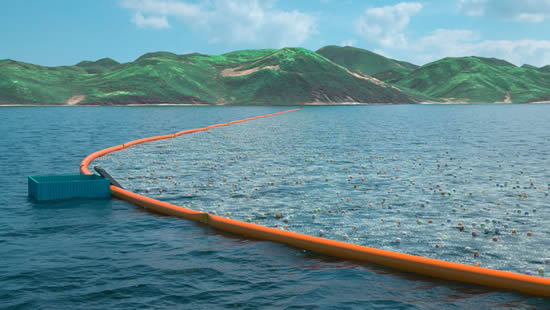Visionary to reality: ridding the oceans of plastic forever
The world’s first system to passively clean up plastic pollution from the world’s oceans is to be deployed in Q2 2016, Boyan Slat, 20-year old founder and CEO of The Ocean Cleanup, announced at Asia’s largest technology conference, Seoul Digital Forum, South-Korea. The feasibility of deployment, off the coast of Tsushima, an island located in the waters between Japan and South-Korea, is currently being researched.
The system will span 2,000m, thereby becoming the longest floating structure ever deployed in the ocean (beating the current record of 1,000m, held by the Tokyo Mega-Float). It will be operational for at least two years, catching plastic pollution before it reaches the shores of the proposed deployment location of Tsushima island. Tsushima island is evaluating whether the plastic can be used as an alternative energy source.
The scale of the plastic pollution problem, whereby in the case of Tsushima island, approximately 1m3 of pollution per person is washed up each year, has led the Japanese the local government to seek innovative solutions to the problem.

The deployment will represents an important milestone in The Ocean Cleanup’s mission to remove plastic pollution from the world’s oceans. Within five years, after a series of deployments of increasing scale, The Ocean Cleanup plans to deploy a 100km-long system to clean up about half the Great Pacific Garbage Patch, between Hawaii and California.
“Taking care of the world’s ocean garbage problem is one of the largest environmental challenges mankind faces today,” said Slat. “Not only will this first cleanup array contribute to cleaner waters and coasts but it simultaneously is an essential step towards our goal of cleaning up the Great Pacific Garbage Patch. This deployment will enable us to study the system’s efficiency and durability over time.”
Aiming one day to rid the oceans of plastic waste, The Ocean Cleanup is a bold pipe dream over which Boyan Slat has obsessed for four years. The idea came to him at the age of 16, in the summer of 2011, when diving in Greece. "I saw more plastic bags than fish," says Slat. He was shocked, and even more shocked that there was no apparent solution. "Everyone said to me: 'Oh there's nothing you can do about plastic once it gets into the oceans,' and I wondered whether that was true."
Four years on, and Boyan Slat's vision has been turned into reality.

TOC's floating barriers use ocean currents to intercept plastic (left, 1), sealife and water flow underneath the tubes (middle, 2), and rubbish collects at the intersection of the tubes (right, 3)
Instead of going after the plastic using boats and nets, The Ocean Cleanup will use long floating barriers, using the natural movement of the ocean currents to passively concentrate the plastic itself (1). Virtually all of the current flows underneath these booms (2), taking away all (neutrally buoyant) sea life, preventing by-catch, while the lighter-than-water plastic collects in front of the floating barrier (3). The scalable array of floating barriers, attached to the seabed, is designed for large-magnitude deployment, covering millions of square kilometers without moving a centimetre.
The Ocean Cleanup’s research into the feasibility of its concept indicates that using a single 100km cleanup array, deployed for 10 years, will passively remove 42% of the great pacific garbage patch. The project conservatively estimates this to be 70,320 tons, tentatively implying a cleanup cost of €4,53/kg.
Facing down comments from critics and realists alike, Slat is determined to see his dream through to the end. The next step for The Ocean Cleanup is, quite literally, to sit and wait for rubbish to start floating in.


